Card Counting the Tiger 7, Ox 6 and Kill the Ox/Tiger Baccarat Side Bets

When the patent on EZ Baccarat and its Dragon 7 side bet expired in September, 2013 (see this post), there was a bit of a land rush. Bally (Shuffle Master) was the first to get in, creating "Fortune Baccarat" with the Fortune 7 side bet. Others have followed. This post considers Dai Bacc, which is a new entry to the same intellectual property landscape.
The main game of Dai Bacc is simply EZ/Fortune Baccarat. This is the non-commission version of baccarat where wagers on Banker push when the Banker wins with a three-card total of 7. For convenience, here is the combinatorial analysis for the Banker bet, showing a house edge of 1.0183%.

Dai Bacc comes with three side bets, described as follows:
Tiger 7. This is simply the Dragon/Fortune 7 bet. It pays 40-to-1 when the Banker hand wins with a three-card total of 7.
Ox 6. This side bet appears to be new. It pays 40-to-1 if the Player hand wins with a three-card total of 6. Recall that EZ Baccarat has the "Panda" side bet, which pays 25-to-1 if the Player hand wins with a three-card total of 8. So, the Ox side bet replaces the still-patented Panda.
Kill the Ox/Tiger. This side bet pays 30-to-1 if one of the following happens:
- The Banker hand is a three-card total of 7 and the Banker hand does not win, or,
- The Player hand is a three-card total of 6 and the Player hand does not win.
Note that if the hand ends with the Banker having a three-card total of 7 and the Player having a three-card total of 6, then both the Tiger 7 and Kill the Ox/Tiger bet win. In other words, despite its name, these wagers are not mutually exclusive. Well, perhaps one can say "the tiger killed the ox."
I am going to cover card counting each of these three side bets in this post. The reader who is used to the themes behind card counting these sorts of side bets will immediately recognize that the key to each of these is getting a three-card hand. In other words, 8's and 9's are very important cards.
On to the results.
Card Counting the Tiger 7 Side Bet
The Tiger 7 side bet wins when the Banker hand has a winning three-card total of 7. This side bet is simply the Dragon/Fortune 7 that I analyze in full detail in this post. As a reminder, here is the combinatorial analysis for the Tiger 7 side bet:

In particular:
- The house edge is 7.611%.
- The standard deviation is 6.085.
- The hit frequency is 2.253%.
The card counting system for the Tiger 7 side bet is the well-known "Dragon count":
- A, 2, 3, T = 0
- 4, 5, 6, 7 = -1
- 8, 9 = -2
I re-ran a fresh one hundred million (100,000,000) eight-deck shoes for this post. Here are the results from this simulation:
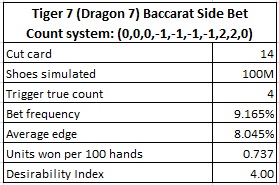
Although this side bet would never be considered a top-level opportunity, it is surprising just how much action it gets internationally. Players are counting it everywhere.
Card Counting the Ox 6 Side Bet
The Ox 6 side bet wins when the Player hand has a winning three-card total of 6. The following table gives the combinatorial analysis for the Ox 6 side bet:

In particular:
- The house edge is 10.338%.
- The standard deviation is 6.000.
- The hit frequency is 2.187%.
A heuristic argument makes the card counting system we're going to present obvious.
First, an excess of 7's, 8's and 9's leads to two-card initial totals that are standing hands or naturals. Without drawing a third card, there is no way to win the Ox 6 bet. Also, if the Player hand does draw, there is no way to get a three-card total of 6 if the drawn third-card is a 7, 8 or 9. It follows that 7's, 8's and 9's are the bad cards for the Ox 6 side bet.
Second, to win the Ox 6 side bet, the Player hand must draw to a 6. Because the Player hand draws whenever the initial two-card total is 0, 1, 2, 3, 4 or 5, it follows that an excess of 6, 5, 4, 3, 2, A helps with this draw. In other words, A, 2, 3, 4, 5, 6 are the good cards for the Ox 6 side bet.
The following table gives the effect-of-removals together with a card counting system:
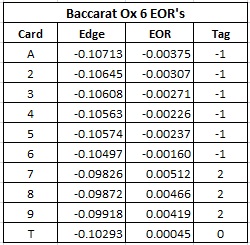
As shown in this table, the card counting system we propose for the Ox 6 side bet is:
- A, 2, 3, 4, 5, 6 = -1
- 7, 8, 9 = +2
- T = 0
This card counting system has a solid betting correlation of 0.980. It is very similar to the Tiger count, with three additional indices for A, 2 and 7. It's easy to imagine how a single card counter could co-card count both the Tiger and Ox side bets.
The following table gives the results of a simulation of one hundred million (100,000,000) eight-deck shoes using the card counting system above to count the Ox 6 side bet:
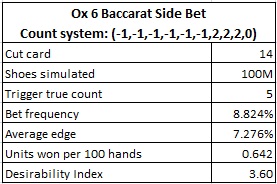
The win-rate for the Ox 6 side bet is comparable to the Tiger 7 (0.642 vs. 0.737 units per 100 hands). The player who counts both simultaneously is winning about 1.379 units per 100 hands, which is quite respectable.
Card Counting the Kill the Ox/Tiger Side Bet
The final side bet offered with Dai Bacc is the somewhat awkward "Kill the Ox/Tiger" (Kill) side bet. In an austere logical format, winning this side bet can be expressed as follows:
The Kill bet WINS when (the Player gets a non-winning three-card total of 6) OR (the Banker gets a non-winning three-card total of 7).
If you're a math geek, you might recall De Morgan's law that states that the following are logically equivalent propositions:
- not-(A OR B)
- (not-A) AND (not-B)
Let
- A = "The Player gets a non-winning three-card total of 6."
- B = "The Banker gets a non-winning three-card total of 7."
Then winning the Kill bet amounts to the proposition "A OR B." So, losing the Kill bet is equivalent to not-(A OR B). Using De Morgan's law, this is equivalent to:
The Kill bet LOSES when (the Player hand is NOT a three-card non-winning 6) AND (the Banker hand is NOT a three-card non-winning 7).
I hope this helps explain the Kill bet, but probably NOT. At any rate, here is the combinatorial analysis for the Kill side bet:

In particular:
- The house edge is 13.756%.
- The standard deviation is 5.098.
- The hit frequency is 2.782%.
Card counting the Kill bet is just as intuitive as counting the Tiger 7 or Ox 6: the player wants the hand to end quickly with a big two-card hand (8's and 9's are good cards) and doesn't want drawing cards that lead to big totals (2, 3, 4, 5, 6, 7 are bad cards).
The following table gives the effect-of-removals together with a card counting system for the Kill side bet:
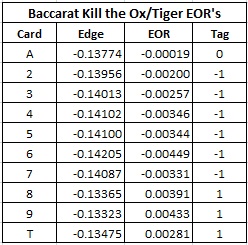
The card counting system we propose for the Kill side bet is:
- 2, 3, 4, 5, 6, 7 = -1
- 8, 9, T = +1
- A = 0
The betting correlation for this system is 0.977. This is remarkably good given the simplicity of the system. There are very few instances of a level-1 count working out for a side bet.
The following table gives the results of a simulation of one hundred million (100,000,000) eight-deck shoes using the card counting system above to count the Kill side bet:
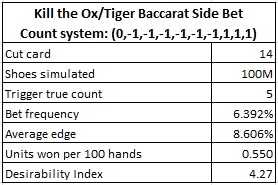
Given the high initial house edge for the Kill side bet, it is surprising just how well this works out for the counter.
Co-Card Counting the Tiger 7, Ox 6 and Kill the Ox/Tiger Side Bets
The following table summarizes the results above for these three side bets:
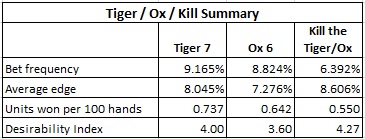
It does not seem reasonable for a single counter to keep track of all three wagers, even with a score card. A team approach may be the strongest attempt.
Imagine three counters playing together at the same table. One of them counts the Tiger 7, the second counts the Ox 6 and the last team member counts the Kill side bet. When the counter for any one of these side bets makes a wager on his bet, the other two teammates also make that wager. It follows that each of teammates individually will win at a rate of:
0.737 + 0.642 + 0.550 = 1.929 units per 100 hands
Together, the team of three counters will win at a rate of 3*1.929 = 5.757 units per 100 hands.
For example, if a $100 maximum wager is permitted on each of these three side bets, then this team will win at a rate of about $576 per 100 hands. If these players can play multiple spots or the maximums are higher, it's even better. On the other hand, a $25 maximum will be a snooze fest.
As far as its overall vulnerability, Dai Bacc is not in the same league of vulnerability as Super Pay Egalite or UR Way Egalite, or the similarly designed ZooBac. It isn't even as good as the recently analyzed Tie Max side bet. However, Dai Bacc is a solid opportunity and casinos that offer Dai Bacc should keep a careful eye on the game.


